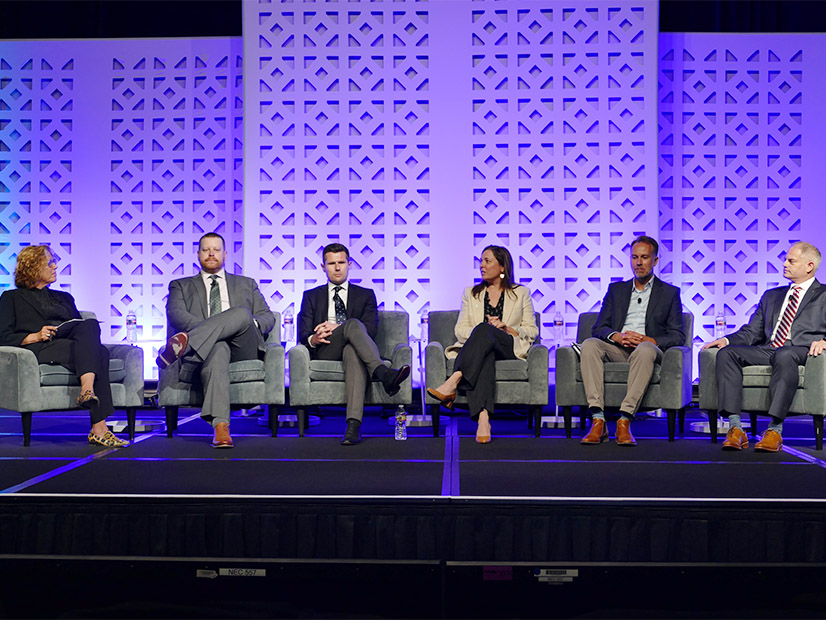
SACRAMENTO, Calif. — Developers of floating offshore wind are calling on the California Public Utilities Commission to increase procurement targets to 10 GW by 2035, up from the initial goal of 2 GW to 5 GW by 2030, accounting for the total combined capacity that can be delivered by the state’s five new leaseholders.
“We and the other leaseholders think that the state should be targeting 10 GW by 2035 as a nice, clear, strong signal of where we’re heading that keeps us on track to meet our climate targets and our offshore wind goals,” Rick Umoff, director of government affairs at Vineyard Offshore, said at the Pacific Offshore Wind Summit, held May 13 to 15 at the SAFE Credit Union Convention Center.
Vineyard Offshore is one of the five companies that obtained leases in June 2023 to develop floating offshore wind off the California coast, and it plans to deploy up to 2 GW of power off Humboldt County. The other leases are held by RWE Offshore Holdings, Invenergy, Equinor and Golden State Wind.
Along with 2 GW to 5 GW by 2030, the California Energy Commission set a goal of deploying 25 GW by 2045. But leaseholders are asking the CPUC to set an interim target of 10 GW by 2035 to stimulate supply chain development and economies of scale needed for investment. The commission is conducting a needs assessment and will have an initial determination by Sept. 1, said an ACP California spokesperson.
“We think it’s incredibly important that the needs assessment recognizes the need for 10 GW of offshore wind development and procurement,” Martin Goff, head of renewables at Equinor, said in a summit panel. “We need to be bold at that type of scale to really get the investment needed in this industry.”
Equinor is responsible for the Atlas Wind project, which will deploy 2 GW of power 60 miles off the coast of Morro Bay. Goff said volume, predictability and certainty are essential to reaching the 10-GW target, and central procurement is one way to get there. The new target would also help signal investment in the transmission needed to accommodate the facilities.
“It’s critical that we have those volumes, the 10 GW, in this needs assessment so that you can trigger that investment in the transmission,” Goff said. “If it’s done on a strategic level, then it takes that transmission away from the generation costs, puts it into a fixed charge … and gets spread out across the state in terms of cost and not put on the developers and the ultimate cost of energy.”
Last year, the state passed AB 1373, enabling the Department of Water Resources to conduct central procurement of eligible long-lead-time resources, including offshore wind, until January 2035. (See California Governor Seeks Central Procurement Authority.) The bill gives developers a positive market signal and the confidence to invest in the substantial and expensive infrastructure needed to build floating offshore wind, Goff said.
“The central procurement entity, it’s a tool in the toolbox,” said Leuwam Tesfai, deputy executive director for energy and climate policy at the CPUC.
Central procurement will ensure that more expensive energy like offshore wind is purchased, said V. John White, executive director at the Center for Energy Efficiency and Renewable Technology.
“I think the challenge is [load-serving entities] aren’t buying these resources on their own because they’re more expensive and because they’re used to buying the cheapest resource possible,” White said. “What the central procurement offers is the opportunity for the PUC to take that decision on behalf of all the LSEs and procure resources competitively knowing that the LSEs are willing to be the ones to take it.”
Cost Concerns
Developers and utilities expressed concern over the costs associated with the buildout of offshore wind and how central procurement could play a role.
“Knowing that these resources are more expensive, how do we know that we’re getting the best price? I think there may need to be some considerations, or what I might call open book bidding, where we would disclose all the costs, the profits … so that you know there’s no hidden markup,” White said.
Cost overruns and ratepayer protection were key among utility concerns when considering central procurement. Adam Smith, director of regulatory relations at Southern California Edison, questioned whether ratepayers would “eat” the substantial costs associated with offshore wind development.
“What we would like to see is that our ratepayers are guaranteed the same guardrails and protections that they would see if the LSEs were doing the procuring,” Smith said. “If the state decides to go there, we just want to make sure our customers are protected.”

